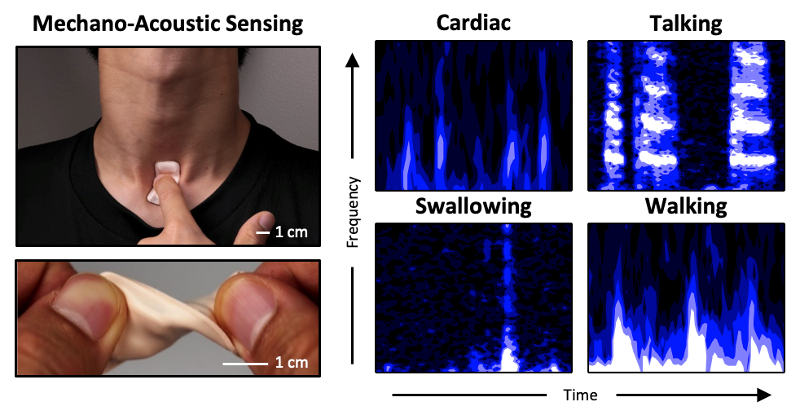Designing the Future of Medical Technologies
Shreyas Hegde
Xiaoyue Ni is pushing her field into the future using smart materials and wearable devices

Xiaoyue Ni is a new assistant professor in the Pratt School of Engineering who works between the Thomas Lord Department of Mechanical Engineering and Materials Science and the School of Medicine’s Department of Biostatistics and Bioinformatics. Her highly interdisciplinary research in the areas of nanomechanics, smart materials, wearable electronics and artificial intelligence encompasses broad fields targeted toward developing intelligent products and materials.
Ni began her term at Duke in November 2020 following a three-year tenure as a postdoctoral researcher at the Querrey Simpson Institute for Bioelectronics at North-western University. She worked under the advisement of John Rogers, the Simpson/Querrey Professor at Northwestern, who is known as a pioneer in flexible electronics. Her work involved developing wearable sensors for human health monitoring, particularly in human body mechanics, as well as advanced metastructures for active and intelligent materials.
Ni’s research focuses on two broad areas—smart materials and wearable technology. While the former is a close amalgamation of her undergraduate and graduate backgrounds, the latter is an area in which she developed expertise while working as a postdoc. The aim of her research is to create smart materials that can sense a human body signal and monitor human activities in real-time.
 “I worked extensively in the area of mechanics of materials during my PhD, particularly in the area of studying deformation microstructures in natural, single crystalline materials like copper,” Ni said. “I’m now aiming to use this knowledge to develop intelligent materials that can have an unparalleled match in terms of artificial microstructures enabling mechanical capabilities. It provides innovative methods to simulate the natural or bio counterparts to perform specific functions.” Ni’s research focuses on developing these metastructures for smart materials, which she refers to as programmable matter.
“I worked extensively in the area of mechanics of materials during my PhD, particularly in the area of studying deformation microstructures in natural, single crystalline materials like copper,” Ni said. “I’m now aiming to use this knowledge to develop intelligent materials that can have an unparalleled match in terms of artificial microstructures enabling mechanical capabilities. It provides innovative methods to simulate the natural or bio counterparts to perform specific functions.” Ni’s research focuses on developing these metastructures for smart materials, which she refers to as programmable matter.
The second area of research involves developing wearable technology, which can be used in real-time diagnostics and treatment. “Collecting real-time data is the experimental way to study human body quantitatively,” said Ni, who adds that this is an area in which doctors and engineers are able to work together to the maximum.
This technology relies on measuring the mechanical and acoustic signals from human bodies using a unique, skin-like device and then post-processing the data using state-of-the-art signal processing and artificial intelligence techniques to extract the information of interest. One of the major challenges, Ni says, is the noise in the data, which must be sorted out from the acoustic signal.
 This area of research is highly interdisciplinary and involves a multitude of both core mechanical and electrical engineering concepts from mechanics, vibration and acoustics to signal processing to the modern-day niche technologies of machine learning and artificial intelligence.
This area of research is highly interdisciplinary and involves a multitude of both core mechanical and electrical engineering concepts from mechanics, vibration and acoustics to signal processing to the modern-day niche technologies of machine learning and artificial intelligence.
Ni concludes by saying that the ultimate goal is to extract the maximum possible amount of high-quality signals to better monitor human bodies continuously. The collected information also serves as feedback for both the development of the next generation of wearable devices and the invention of novel artificial biomaterials. Their incorporation will provide insights for realizing a seamless human-material interaction in the future.
Ni’s work is a duet of fundamental materials science combined with concepts derived from pure science fields, particularly physics.
“I love the interdisciplinary nature of Duke,” said Ni, when asked why she chose to come to Duke. “The engineering and medical schools being in close proximity enables doctors to be mentally connected to engineers. This enables highly efficient cross-collaboration research, which makes Duke unique.”
Shreyas Hegde is a PhD student in the Aeroelasticity Lab, advised by Professor Bob Kielb.
